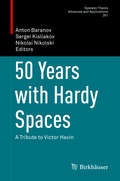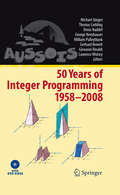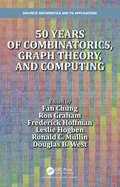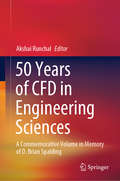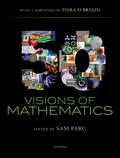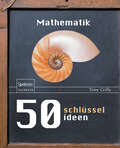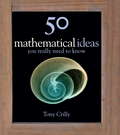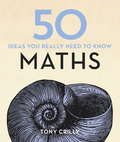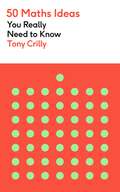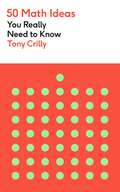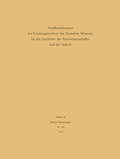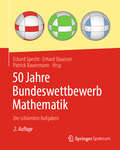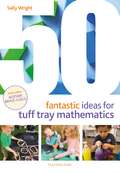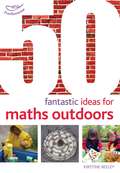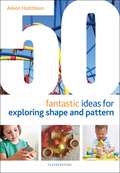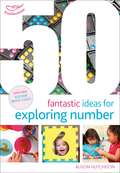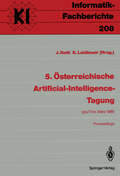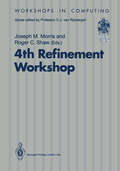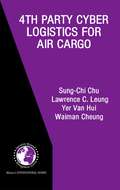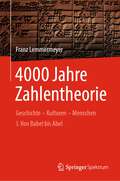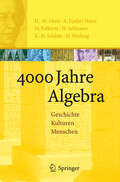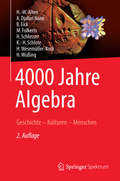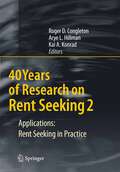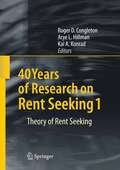- Table View
- List View
50 Years with Hardy Spaces: A Tribute to Victor Havin (Operator Theory: Advances and Applications #261)
by Anton Baranov Sergei Kisliakov Nikolai NikolskiWritten in honor of Victor Havin (1933–2015), this volume presents a collection of surveys and original papers on harmonic and complex analysis, function spaces and related topics, authored by internationally recognized experts in the fields. It also features an illustrated scientific biography of Victor Havin, one of the leading analysts of the second half of the 20th century and founder of the Saint Petersburg Analysis Seminar. A complete list of his publications, as well as his public speech "Mathematics as a source of certainty and uncertainty", presented at the Doctor Honoris Causa ceremony at Linköping University, are also included.
50 Years of Integer Programming 1958-2008: From the Early Years to the State-of-the-Art
by Michael Jünger Thomas M. Liebling Denis Naddef George L. Nemhauser William R. Pulleyblank Gerhard Reinelt Giovanni Rinaldi Laurence A. WolseyIn 1958, Ralph E. Gomory transformed the field of integer programming when he published a paper that described a cutting-plane algorithm for pure integer programs and announced that the method could be refined to give a finite algorithm for integer programming. In 2008, to commemorate the anniversary of this seminal paper, a special workshop celebrating fifty years of integer programming was held in Aussois, France, as part of the 12th Combinatorial Optimization Workshop.It contains reprints of key historical articles and written versions of survey lectures on six of the hottest topics in the field by distinguished members of the integer programming community. Useful for anyone in mathematics, computer science and operations research, this book exposes mathematical optimization, specifically integer programming and combinatorial optimization, to a broad audience.
50 years of Combinatorics, Graph Theory, and Computing (Discrete Mathematics and Its Applications)
by Fan Chung, Ron Graham, Frederick Hoffman, Leslie Hogben, Ronald C. Mullin and Douglas B. West50 Years of Combinatorics, Graph Theory, and Computing advances research in discrete mathematics by providing current research surveys, each written by experts in their subjects. The book also celebrates outstanding mathematics from 50 years at the Southeastern International Conference on Combinatorics, Graph Theory & Computing (SEICCGTC). The conference is noted for the dissemination and stimulation of research, while fostering collaborations among mathematical scientists at all stages of their careers. The authors of the chapters highlight open questions. The sections of the book include: Combinatorics; Graph Theory; Combinatorial Matrix Theory; Designs, Geometry, Packing and Covering. Readers will discover the breadth and depth of the presentations at the SEICCGTC, as well as current research in combinatorics, graph theory and computer science.Features: Commemorates 50 years of the Southeastern International Conference on Combinatorics, Graph Theory & Computing with research surveys Surveys highlight open questions to inspire further research Chapters are written by experts in their fields Extensive bibliographies are provided at the end of each chapter
50 years of Combinatorics, Graph Theory, and Computing (Discrete Mathematics and Its Applications)
by Ronald C. Mullin Leslie Hogben Douglas B. West Fan Chung Ron Graham Frederick Hoffman50 Years of Combinatorics, Graph Theory, and Computing advances research in discrete mathematics by providing current research surveys, each written by experts in their subjects. The book also celebrates outstanding mathematics from 50 years at the Southeastern International Conference on Combinatorics, Graph Theory & Computing (SEICCGTC). The conference is noted for the dissemination and stimulation of research, while fostering collaborations among mathematical scientists at all stages of their careers. The authors of the chapters highlight open questions. The sections of the book include: Combinatorics; Graph Theory; Combinatorial Matrix Theory; Designs, Geometry, Packing and Covering. Readers will discover the breadth and depth of the presentations at the SEICCGTC, as well as current research in combinatorics, graph theory and computer science.Features: Commemorates 50 years of the Southeastern International Conference on Combinatorics, Graph Theory & Computing with research surveys Surveys highlight open questions to inspire further research Chapters are written by experts in their fields Extensive bibliographies are provided at the end of each chapter
50 Years of CFD in Engineering Sciences: A Commemorative Volume in Memory of D. Brian Spalding
by Akshai RunchalProf. D. Brian Spalding, working with a small group of students and colleagues at Imperial College, London in the mid-to late-1960’s, single-handedly pioneered the use of Computational Fluid Dynamics (CFD) for engineering practice.This book brings together advances in computational fluid dynamics in a collection of chapters authored by leading researchers, many of them students or associates of Prof. Spalding. The book intends to capture the key developments in specific fields of activity that have been transformed by application of CFD in the last 50 years. The focus is on review of the impact of CFD on these selected fields and of the novel applications that CFD has made possible. Some of the chapters trace the history of developments in a specific field and the role played by Spalding and his contributions. The volume also includes a biographical summary of Brian Spalding as a person and as a scientist, as well as tributes to Brian Spalding by those whose life was impacted by his innovations. This volume would be of special interest to researchers, practicing engineers, and graduate students in various fields, including aerospace, energy, power and propulsion, transportation, combustion, management of the environment, health and pharmaceutical sciences.
50 Visions of Mathematics
by Dara O' BriainRelax: no one understands technical mathematics without lengthy training but we all have an intuitive grasp of the ideas behind the symbols. To celebrate the 50th anniversary of the founding of the Institute of Mathematics and its Applications (IMA), this book is designed to showcase the beauty of mathematics - including images inspired by mathematical problems - together with its unreasonable effectiveness and applicability, without frying your brain. The book is a collection of 50 original essays contributed by a wide variety of authors. It contains articles by some of the best expositors of the subject (du Sautoy, Singh and Stewart for example) together with entertaining biographical pieces and articles of relevance to our everyday lives (such as Spiegelhalter on risk and Elwes on medical imaging). The topics covered are deliberately diverse and involve concepts from simple numerology to the very cutting edge of mathematics research. Each article is designed to be read in one sitting and to be accessible to a general audience. There is also other content. There are 50 pictorial 'visions of mathematics' which were supplied in response to an open call for contributions from IMA members, Plus readers and the worldwide mathematics community. You'll also find a series of "proofs " of Phythagoras's Theorem - mathematical, literary and comedy - after this, you'll never think of Pythagoras the same way again.
50 Schlüsselideen Mathematik
by Tony CrillyDieser verständlich geschriebene Führer zur Gedankenwelt der Mathematik erklärt in kompakten und klaren Essays 50 zentrale Konzepte der Disziplin. Mit anschaulichen Grafiken, zahlreichen Beispiele und unterhaltsamen Anekdoten eröffnet das Buch auch denjenigen den Zugang, die ansonsten schon bei der bloßen Erwähnung des Wortes Mathematik in Panik geraten. Zu den näher erläuterten Schlüsselideen zählen imaginäre Zahlen, goldene Rechtecke und magische Quadrate ebenso wie die Gesetze der Genetik und das Geburtstagsproblem. Indem das Werk die Wissenschaft hinter den 50 entscheidenden Einsichten erkundet – vom Einfachen (wie der Zahl 1) über das Subtile (die Erfindung der Null) bis zum Komplexen (dem Beweis des Fermat’schen Theorems) –, verdeutlicht es auch, wie die Mathematik unsere Sicht auf die Welt verändert hat. Ohne die Erkenntnisse dieser Disziplin wären wir jedenfalls nicht dort, wo wir heute stehen. Mit diesem Buch können Sie mitreden.
50 Maths Ideas You Really Need to Know (50 Ideas You Really Need to Know series)
by Tony CrillyJust the mention of mathematics is enough to strike fear into the hearts of many, yet without it, the human race couldn't be where it is today. By exploring the subject through its 50 key insights - from the simple (the number one) and the subtle (the invention of zero) to the sophisticated (proving Fermat's last theorem) - this book shows how mathematics has changed the way we look at the world around us.
50 Maths Ideas You Really Need to Know (50 Ideas You Really Need to Know series)
by Tony CrillyWho invented zero? Why 60 seconds in a minute? How big is infinity? Where do parallel lines meet? And can a butterfly's wings really cause a storm on the far side of the world? In 50 Maths Ideas You Really Need to Know, Professor Tony Crilly explains in 50 clear and concise essays the mathematical concepts - ancient and modern, theoretical and practical, everyday and esoteric - that allow us to understand and shape the world around us. Packed with diagrams, examples and anecdotes, this book is the perfect overview of this often daunting but always essential subject. For once, mathematics couldn't be simpler. Contents include: Origins of mathematics, from Egyptian fractions to Roman numerals; Pi and primes, Fibonacci numbers and the golden ratio; What calculus, statistics and algebra can actually do; The very real uses of imaginary numbers; The Big Ideas of relativity, Chaos theory, Fractals, Genetics and hyperspace; The reasoning behind Sudoku and code cracking, Lotteries and gambling, Money management and compound interest; Solving of Fermat's last theorem and the million-dollar question of the Riemann hypothesis.
50 Maths Ideas You Really Need to Know (50 Ideas You Really Need to Know series)
by Tony CrillyIn a series of 50 accessible essays, Tony Crilly explains and introduces the mathematical laws and principles -ancient and modern, theoretical and practical, everyday and esoteric - that allow us to understand the world around us.From Pascal's triangle to money management, ideas of relativity to the very real uses of imaginary numbers, 50 Maths Ideas is a complete introduction to the most important mathematical concepts in history.
50 Maths Ideas You Really Need to Know (50 Ideas You Really Need to Know series)
by Tony CrillyIn a series of 50 accessible essays, Tony Crilly explains and introduces the mathematical laws and principles-ancient and modern, theoretical and practical, everyday and esoteric-that allow us to understand the world around us.From Pascal's triangle to money management, ideas of relativity to the very real uses of imaginary numbers, 50 Math Ideas is a complete introduction to the most important mathematical concepts in history.
50 Jahre GAMM: Im Auftrag und unter Mitwirkung des Fachausschusses für die Geschichte der GAMM
by Gesellschaft für Angewandte Mathematik und Mechanik Helmuth Gericke50 Jahre Bundeswettbewerb Mathematik: Die schönsten Aufgaben
Dieses Buch wird alle Liebhaber der Mathematik (und die es werden wollen) durch eine Fülle von reizvollen und unterhaltsamen Problemstellungen aus Algebra, Geometrie, Kombinatorik und Zahlentheorie begeistern. Vierzig ausgewählte Aufgaben aus 50 Jahren Bundeswettbewerb Mathematik werden mit ausführlichen Lösungen, Einblicken in das mathematische Umfeld und inhaltlichen Variationen reich illustriert präsentiert. Von der Mathematik geht für viele seit jeher eine besondere Faszination aus. Wer tiefer in sie eindringt, entdeckt ihre Schönheit, ihre Eleganz und ihre unendliche Vielfalt und stößt immer wieder auf überraschende Resultate. Hiermit bereits bei Schülerinnen und Schülern Interesse zu wecken, ist eines der Anliegen des Bundeswettbewerbs Mathematik. Mit seinen außergewöhnlichen Aufgaben regt er seit nunmehr einem halben Jahrhundert Jugendliche an, sich intensiv mit elementarer Mathematik auf höherem Niveau zu beschäftigen und Erfahrungen im Problemlösen zu sammeln.Anhand von ausgewählten und besonders ansprechenden Problemstellungen dokumentiert dieses Buch deren Reiz und beleuchtet ihren jeweiligen mathematischen Hintergrund. Darüber hinaus sind alle Aufgaben, die seit dem ersten Lauf des Bundeswettbewerbs Mathematik im Schuljahr 1970/71 gestellt worden sind, vollständig enthalten.
50 Fantastic Ideas for Tuff Tray Mathematics (50 Fantastic Ideas)
by Sally WrightThe tuff tray is a staple resource in Early Years settings that supports many different styles of learning and play, including incorporating early mathematics through invitations to play. The tuff tray is extremely versatile and its shape and height promotes collaborative play as young children negotiate space and resources.50 Fantastic Ideas for Tuff Tray Mathematics is filled with inspiring ideas for exploring mathematical concepts such as size, shape, capacity, quantity, distance, volume and numbers using tuff trays. From exploring time with ice cubes to cutting shapes out of tortilla wraps, Sally Wright presents opportunities for mathematical learning objectives to be met in an exciting and creative way.
50 Fantastic Ideas For Maths Outdoors (PDF)
by Kirstine Beeley Alistair Bryce-CleggOutdoor learning is not just about taking what we do indoors and moving it out through the door of our setting. It involves equipment and experiences which are both unique and exciting. When planning for maths provision practitioners need to make sure they offer access to these amazing opportunities for learning and integrate them into children's ongoing play and exploration of their natural world. Designed to be used as a dip in dip out collection of easy to use ideas the author has tried to show how exciting outdoor learning can be developed on even the very smallest of budgets. As with all areas of early learning the author acknowledges the way that maths is integrated within play based exploration and linked to many other areas of learning. Offering ways to develop your existing provision as well as building new resources you will enjoy exploring all areas of early maths including number, pattern,shape and measuring.
50 Fantastic Ideas for Exploring Shape and Pattern (50 Fantastic Ideas)
by Alison Hutchison50 Fantastic Ideas for Exploring Shape and Pattern features activities and games filled with rich contexts for learning and discussion, as well as fun opportunities for consolidation and problem-solving.Alison Hutchison draws on her wealth of experience to present ideas in line with the Early Learning Goals for investigating shape and pattern in the world around us. She focuses on helping young children to make connections and develop language, knowledge and understanding of shape and pattern. Whether children build with fabric blocks to create patterns or explore symmetry while playing with natural materials, the easy-to-prepare activities in this book facilitate engaging learning opportunities for children's ideas and interests to be explored.
50 Fantastic Ideas for Exploring Number (50 Fantastic Ideas)
by Alison Hutchison Alistair Bryce-CleggDeveloping a secure understanding of number in the Early Years is key to ensuring number confidence for future stages of learning. A wide variety of meaningful hands-on experiences are required to develop a child's deep understanding of number. 50 Fantastic Ideas for Exploring Number presents ideas that are all about doing – to not only stimulate the senses, but to also provoke thinking and talking, allow questions to be asked, and ensure that links are made between number concepts and the real world. The ideas require little preparation beforehand, can be used by practitioners without any specific expertise in teaching early number, and include easy-to-source materials. Each area of early number sense is covered from adding on and taking away to number stories, identifying and writing numbers.Alison Hutchison draws on her wealth of experience to present 50 ideas and experiences that make numbers fun and accessible so that, as they explore and investigate, children are fully engaged partners in their learning at this crucial early stage of their number journey.
5. Österreichische Artificial-Intelligence-Tagung: Igls/Tirol, 28.-31. März 1989 Proceedings (Informatik-Fachberichte #208)
by Johannes Retti Karl Leidlmair4th Refinement Workshop: Proceedings of the 4th Refinement Workshop, organised by BCS-FACS, 9–11 January 1991, Cambridge (Workshops in Computing)
by Joseph M. Morris Roger C. ShawThis volume contains the proceedings ofthe 4th Refinement Workshop which was organised by the British Computer Society specialist group in Formal Aspects of Computing Science and held in Wolfson College, Cambridge, on 9-11 January, 1991. The term refinement embraces the theory and practice of using formal methods for specifying and implementing hardware and software. Most of the achievements to date in the field have been in developing the theoretical framework for mathematical approaches to programming, and on the practical side in formally specifying software, while more recently we have seen the development of practical approaches to deriving programs from their speCifications. The workshop gives a fair picture of the state of the art: it presents new theories for reasoning about software and hardware and case studies in applying known theory to interesting small-and medium-scale problems. We hope the book will be Of interest both to researchers in formal methods, and to software engineers in industry who want to keep abreast of possible applications of formal methods in industry. The programme consisted both of invited talks and refereed papers. The invited speakers were Ib S0rensen, Jean-Raymond Abrial, Donald MacKenzie, Ralph Back, Robert Milne, Mike Read, Mike Gordon, and Robert Worden who gave the introductory talk. This is the first refinement workshop that solicited papers for refereeing, and despite a rather late call for papers the response was excellent.
4th Party Cyber Logistics for Air Cargo (International Series in Operations Research & Management Science #73)
by Sung-Chi Chu Lawrence C. Leung Yer Van Hui Waiman Cheung4th Party Cyber Logistics For Air Cargo is a technical discussion for researchers and practitioners to understand the issues, models, and future directions of air cargo logistics in the cyber era. This book introduces the many aspects of planning and control of air cargo logistics processes in an e-Business environment. The authors approach this subject matter from the perspective of the logistics service providers. There is tremendous potential of achieving industry-wide collaboration between agents of the air cargo industry via an e-Business community platform. At the same time, there are many intellectually challenging problems regarding the architecture, ownership, decision support environment, and knowledge management of such an e-Business platform. The authors provide an evolutionary view to conceptualize the developments of websites where e-Commerce activities and e-Business activities co-exist. Four Web eras are detailed, providing an impetus for the development of frameworks of an e-Business platform for air cargo logistics, or e-Platform. The conceptual framework captures the new elements in cyber logistics and what the framework can do for the industry.
4000 Jahre Zahlentheorie: Geschichte - Kulturen - Menschen I. Von Babel bis Abel (Vom Zählstein zum Computer)
by Franz Lemmermeyer4000 Jahre Zahlentheorie nimmt die Leser und Leserinnen mit auf eine Reise durch die Geschichte eines lange Zeit belächelten Gebiets der Mathematik. Im ersten Teil wird das Auf und Ab mathematischer Kulturen geschildert, beginnend mit den ersten zahlentheoretischen Fragestellungen der Babylonier, dem Studium von Primzahlen und vollkommenen Zahlen bei den Griechen und in der islamischen Welt, bis zu den Untersuchungen rechtwinkliger Dreiecke mit ganzzahligen Seitenlängen in Indien und China. Die Erfindung des Buchdrucks und die Wiederentdeckung der griechischen Mathematik, insbesondere des Werks von Diophant, führte zu einem ungeheuren Aufschwung in der Zahlentheorie unter den Händen von Fermat, Euler, Lagrange und Legendre bis hin zu Gauß und seinem Jahrhundertwerk, den Disquisitiones Arithmeticae. Der dritte Teil beschäftigt sich mit der Generation von Zahlentheoretikern nach Gauß, die sich intensiv mit den Disquisitiones auseinandergesetzt haben und welche mit der Anwendung analytischer Methoden Ergebnisse erzielt haben, welche mit elementaren Techniken nur schwer oder gar nicht erreichbar sind; dazu gehören Dirichlet, Jacobi, Abel und Eisenstein. Während die Zahlentheorie bis Fermat nur wenige Kenntnisse der Mathematik verlangt, benötigt man für das Verständnis des Eulerschen Werks bereits Vertrautheit mit der Oberstufenanalysis, danach punktuell auch deutlich mehr.
4000 Jahre Algebra: Geschichte. Kulturen. Menschen (Vom Zählstein zum Computer)
by Heinz-Wilhelm Alten A. Djafari Naini Menso Folkerts Hartmut Schlosser Karl-Heinz Schlote Hans Wußing4000 Jahre Algebra: Geschichte – Kulturen – Menschen (Vom Zählstein zum Computer)
by H.-W. Alten A. Djafari Naini B. Eick M. Folkerts H. Schlosser K.-H. Schlote H. Wesemüller-Kock H. WußingDie Entstehung, Entwicklung und Wandlung der Algebra als Teil unserer Kulturgeschichte beschreiben Wissenschaftler von fünf Universitäten. Ursprünge, Anstöße und die Entwicklung algebraischer Begriffe und Methoden werden in enger Verflechtung mit historischen Ereignissen und menschlichen Schicksalen dargestellt. Ein erster Spannungsbogen reicht von den Frühformen des Rechnens mit natürlichen Zahlen und Brüchen zur Lösung einfacher Gleichungen bis hin zur Lösung von Gleichungen dritten und vierten Grades in der Renaissance. Von den misslungenen Versuchen zur Lösung allgemeiner Gleichungen höheren Grades im 17 Jh. zieht sich ein weiterer Bogen zu den berühmten Beweisen des Fundamentalsatzes der Algebra durch Gauß und den genialen Ideen des jungen Galois. Die Wandlung der Algebra von der Gleichungslehre zur Theorie algebraischer Strukturen wird danach ebenso beschrieben, wie die völlig neuen Akzente, die die Computeralgebra in neuester Zeit gesetzt hat. Viele neue farbige Abbildungen bereichern die inhaltlichen Aktualisierungen und Textergänzungen.
40 Years of Research on Rent Seeking 2: Applications: Rent Seeking in Practice
The last survey of the rent-seeking literature took place more than a decade ago. Since that time a great deal of new research has been published in a wide variety of journals, covering a wide variety of topics. The scope of that research is such that very few researchers will be familiar with more than a small part of contemporary research, and very few libraries will be able to provide access to the full breadth of that research. This two-volume collection provides an extensive overview of 40 years of rent-seeking research. The volumes include the foundational papers, many of which have not been in print for two decades. They include recent game-theoretic analyses of rent-seeking contests and also appUcations of the rent-seeking concepts and methodology to economic regulation, international trade policy, economic history, poUtical com petition, and other social phenomena. The new collection is more than twice as large as any previous collection and both updates and extends the earUer surveys. Volume I contains previously pubhshed research on the theory of rent-seeking contests, which is an important strand of contemporary game theory. Volume II contains previously published research that uses the theory of rent-seeking to an alyze a broad range of public policy and social science topics. The editors spent more than a year assembling possible papers and, although the selections fill two large volumes, many more papers could have been included.
40 Years of Research on Rent Seeking 1: Theory of Rent Seeking
The last survey of the rent-seeking literature took place more than a decade ago. Since that time a great deal of new research has been published in a wide variety of journals, covering a wide variety of topics. The scope of that research is such that very few researchers will be familiar with more than a small part of contemporary research, and very few libraries will be able to provide access to the full breadth of that research. This two-volume collection provides an extensive overview of 40 years of rent-seeking research. The volumes include the foundational papers, many of which have not been in print for two decades. They include recent game-theoretic analyses of rent-seeking contests and also appHcations of the rent-seeking concepts and methodology to economic regulation, international trade policy, economic history, poUtical com petition, and other social phenomena. The new collection is more than twice as large as any previous collection and both updates and extends the earlier surveys. Volume I contains previously published research on the theory of rent-seeking contests, which is an important strand of contemporary game theory. Volume II contains previously pubHshed research that uses the theory of rent-seeking to an alyze a broad range of public policy and social science topics. The editors spent more than a year assembling possible papers and, although the selections fill two large volumes, many more papers could have been included.
